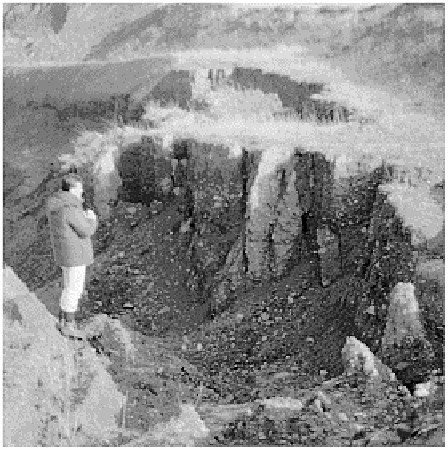Environmental Engineering Reference
In-Depth Information
Plate 13.12
Toppling of cohesive, glaciofluvial gravels in a
quarry face, after tension cracking behind the working face
(right). The figure is standing on a toppled block.
Photo: Ken Addison.
DEBRIS FLOW HAZARD AND STRUCTURAL DAMAGE
human impact
Debris flows are among the most unpredictable, fast-moving forms of mass wasting
process, capable of self-regeneration in transit. For these reasons they pose particular
hazards to human settlements and structures. They are initiated by a wide range of stimuli
- landslides, seismic activity, intense rainfall, rapid snow or glacier melt, water eruption
(e.g. a bursting pipe), volcanic eruption, etc. - depending on the critical condition of
slope materials at the time of potential failure. Their essential requirement is rapid
fluidization of granular debris, hence the rapid water delivery and/or high-porosity debris
components listed. They are common on arctic and alpine slopes (see Chapter 25).
Explosive eruptions on ice-capped strato-volcanoes generate some of the most
spectacular, destructive debris flows and provide their own granular debris in the form of
ash falls.
Debris flows and
lahars
(volcanic mud flows) triggered by the Nevado del Ruiz
eruption in Colombia (1985) swept over tens of kilometres and claimed more than 25,000
lives. The 1980 Mount St Helens eruption in Washington State (USA) claimed few lives
but debris flows travelled over 20 km along the Toutle river valley. The ty pical sequence
of events started with an earthquake, triggering the eruption via a major landslide which
opened up the blast vent Unconsolidated slope materials were disturbed by both shocks





